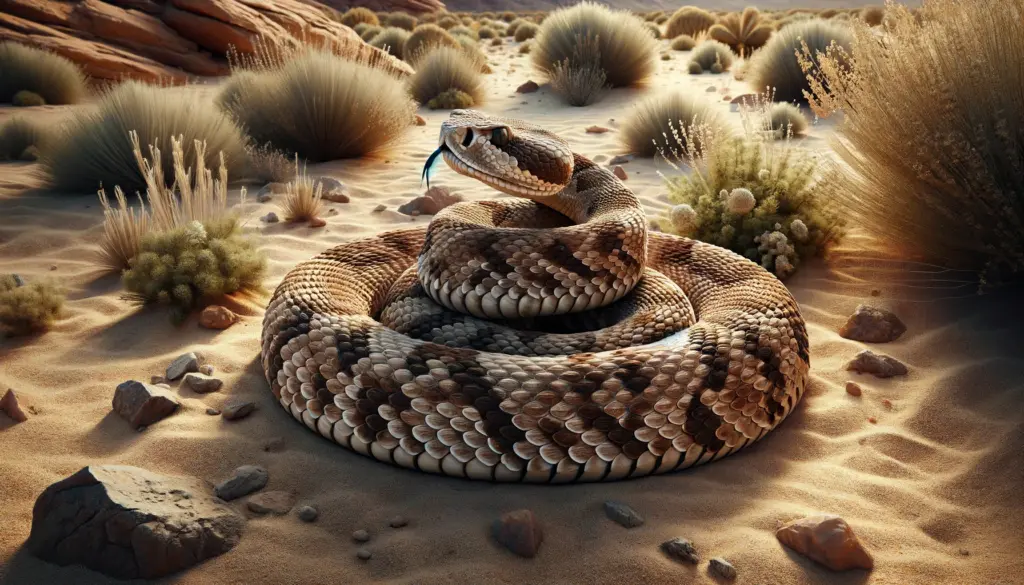Have you ever wondered about rattlesnakes and whether they lay eggs? In this blog post, You’ll learn about how these fascinating creatures reproduce, their life stages, and we’ll talk some common myths about them along the way.
Understanding Rattlesnakes
What Are Rattlesnakes?
Rattlesnakes are a group of venomous snakes known for the distinctive rattle at the end of their tails. They belong to the pit viper family and are found mainly in the Americas, from southern Canada to central Argentina.
These snakes prefer arid environments like deserts and dry plains, but they can also be found in forests and swamps.
Characteristics of Rattlesnakes

Rattlesnakes are easily recognized by their thick bodies, triangular heads, and the segments at the end of their tails that make a rattling sound to warn predators and intruders.
They can vary in color, but they usually blend well with their natural surroundings, which helps them avoid predators and sneak up on their prey.
Reproduction of Rattlesnakes
How Do Rattlesnakes Reproduce?
Rattlesnakes are fascinating when it comes to reproduction because they do not lay eggs outside their body. Instead, they are ovoviviparous, meaning the eggs develop inside the female’s body and the young are born live.
Do Rattlesnakes Lay Eggs?
No, rattlesnakes do not lay eggs. They carry their eggs inside their bodies until they are ready to hatch. When the young are ready to come out, they are born fully formed. This method protects the young snakes from environmental threats and predators that might harm eggs left in a nest.
The Life Cycle of a Rattlesnake
From Birth to Adulthood
Watching a rattlesnake grow from a newborn to an adult is truly fascinating. Right from the start, baby rattlesnakes are on their own. They’re born with what looks like a tiny button on their tails, which is the beginning of their rattles.
Even at this young age, they can hunt and use their venom to catch small prey like insects and tiny mice. As they grow older, they shed their skin several times. With each shedding, their rattle gets another segment, and they grow bigger and stronger.
Here’s how they develop over time:
- Birth: Born with a pre-button rattle, capable of hunting.
- Juvenile: Grow rapidly, learning to target larger prey.
- Adult: Fully developed rattle, proficient hunters able to take down sizable prey.
This growth process not only makes them more capable hunters but also more likely to survive in the wild. Each stage of their life prepares them for the challenges they’ll face in their natural habitat.
Common Myths About Rattlesnakes

Myths vs. Facts
There are plenty of stories out there about rattlesnakes that just aren’t true. One of the biggest myths is that rattlesnakes always rattle before they strike. The truth is, they can strike quietly if they feel threatened and need to defend themselves quickly.
Another common misconception is that all rattlesnakes lay eggs. However, rattlesnakes are ovoviviparous, meaning they give birth to live young instead of laying eggs. Here’s a quick breakdown of fact vs. fiction:
- Myth: Rattlesnakes always rattle before striking.
- Fact: They can strike without warning if necessary.
- Myth: Rattlesnakes lay eggs.
- Fact: They give birth to live young.
Knowing these facts helps us understand how to behave safely around rattlesnakes and appreciate their role in nature rather than fearing them based on false information.
Protecting Rattlesnakes and Their Habitats
Conservation Efforts for Rattlesnakes
Keeping rattlesnakes safe is vital for keeping our ecosystems balanced. Rattlesnakes help control the populations of rodents and other small animals, which can carry diseases that affect humans and crops.
By keeping these populations in check, rattlesnakes prevent the spread of disease and crop damage. Here are the main focuses of rattlesnake conservation:
- Habitat Preservation: Ensuring that rattlesnakes have safe places to live, hunt, and reproduce.
- Education: Helping people understand the importance of rattlesnakes reduces fear and promotes coexistence.
These efforts are essential for the survival of rattlesnakes and for the health of our natural environments. By learning about and supporting these efforts, we can help maintain the delicate balance of our ecosystems.
FAQs Related to “Do Rattlesnakes Lay Eggs”
Not all snakes lay eggs. Like rattlesnakes, some snakes are ovoviviparous and give birth to live young, while others lay eggs.
Many snake species, like most pythons and cobras, lay eggs. They typically lay them in a hidden nest and may guard them until they hatch.
You can identify a rattlesnake by its thick, heavy body, distinctive rattle at the tail’s end, and a triangular-shaped head.
Rattlesnakes are mostly found in the Americas, from Canada to Argentina, preferring arid regions like deserts but also dwelling in forests and swamps.
Oviparous snakes lay eggs that hatch outside their body, while ovoviviparous snakes, like rattlesnakes, keep their eggs inside until they hatch, giving birth to live young.
The number can vary widely, but typically, a rattlesnake can give birth to 5 to 20 babies at a time.
Baby rattlesnakes usually eat small lizards and small rodents, which they can subdue with their venom.
Rattlesnakes can live up to 20 to 30 years in the wild, depending on the species and environmental conditions.
No, you cannot accurately tell the age of a rattlesnake by its rattles because rattles can break off, and they gain a new segment each time they shed their skin, which isn’t tied to a specific time frame.
Yes, rattlesnakes can be dangerous as they are venomous. However, they generally avoid humans and only strike when threatened or provoked.
Conclusion
In this post, we’ve explored how rattlesnakes reproduce, their life cycle, and addressed some common myths. Remember, rattlesnakes are not egg-layers; they give birth to live young.
By understanding more about these remarkable snakes, we can appreciate their role in nature and the importance of their conservation.
Read More On: do whales lay eggs

